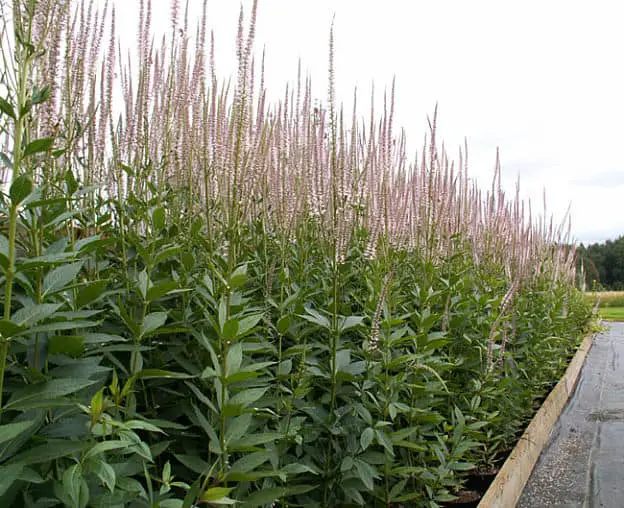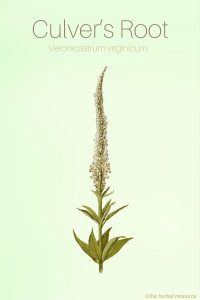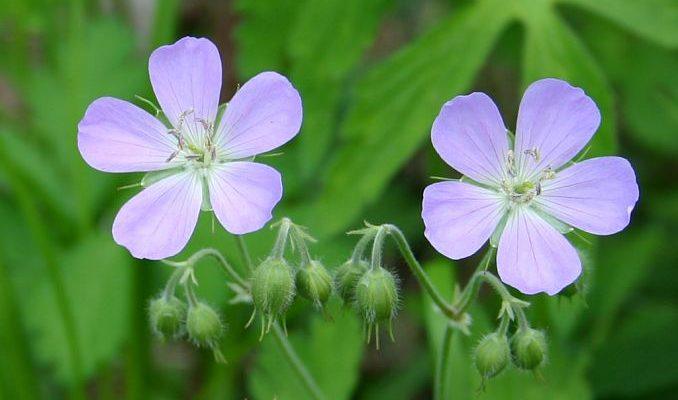Botanical Name: Veronicastrum virginicum.
The common name “Culver’s root” comes from Dr. Culver, an eighteenth-century physician who promoted the use of this plant as medicine at that time.
Other Common Names: Black root, Culver’s physic, Brinton’s root, Bowman’s Root, Beaumont’s root, tall speedwell, tall veronica, whorlywort, kransveronika (Swedish), Virginischer Ehrenpreis (German), culver (Spanish), skessudepla (Icelandic).
Habitat: The plant is native to eastern North America, ranging from Ontario to Manitoba, and south to Massachusetts, Alabama, and Texas. The plant prefers moist to wet habitats and occurs in marshes, along river edges, prairies, meadows, and open woodlands.
Description: Culver’s root is a perennial plant, belonging to the Scrophulariaceae or the figwort family, which can grow up to 5 feet tall (1.50 m).
The rootstock which is horizontal, cylindrical, black or dark red to dark brown and produces an upright, smooth and unbranched stalk. The leaves are lanceolate or oblong, finely toothed and are scattered along the stem in whorls (3-7 leaves per whorl).
At the apex of the plant are slender spikes with numerous white, pink or blue flowers. The plant blooms from midsummer until September.
Plant Parts Used: It is the rootstock of the plant that is used as herbal medicine. The roots are usually dug up in autumn and dried for later use in decoction, liquid extracts, powders, tablets, and tinctures.
The dried roots should preferably be stored for at least one year before they are used in order to lessen the herb’s strong potency.

Common Therapeutic Uses and Benefits of Culver’s Root
Active Ingredient and Substances: Culver’s root contains essential oil, phenolic acids, some bitter substances, phytosterol, alkaloids, tannins, mannitol, dextrose, resins, and saponins.
Traditional Use of Culver’s Root
The Native Americans used the plant for its therapeutic properties but they also used it for spiritual purposes.
Native American tribes in Missouri and Delaware used the herb as a laxative while the Ojibwe or the Chippewa tribe used the root as a “blood purifier”. The Seneca Indians used the plant in tea form to induce vomiting as a part of purification rituals.
The use of the herb, mostly in moderate doses, as a laxative and detoxifying agent was adopted early on by the European settlers.
Later the herb was used as a remedy for liver diseases and to stimulate bile production. In addition, it was also used to treat malaria and typhoid fever.
Culver’s root was once included in United States Pharmacopoeia but it’s not commonly used today because its strong potency is difficult to control.
A Remedy for the Liver and Gallbladder
Culver’s root can affect the liver and gallbladder by increasing the production and secretion of bile, which lubricates the intestines which in turns enhances bowel movements.
The herb is therefore sometimes used as a treatment for chronic constipation, irritation of the intestines and ailments related to the liver and gallbladder such as hepatitis, cholecystitis, jaundice and other conditions which are believed to be caused by poor liver function (eg. some skin diseases).
The herb may also be of value as a remedy for diarrhea, bloating, chronic indigestion, hemorrhoids, and anal prolapse.
It should also be noted that the herb has emetic properties.
Culver’s root is often combined with dandelion (Taraxacum officinale) and barberry (Berberis vulgaris).
As a treatment for liver ailments and when used as a remedy for constipation it may be combined with the herb sweet flag (Acorus calamus) and goldenseal (Hydrastis canadensis).
Therapeutic Dosages
Culver’s root usually works best in small doses that are administered repeatedly over an extended period of time.
As a decoction: 1 or 2 teaspoons of the dried rhizome and roots in a cup of cold water which is then brought to boiling point, then simmered for 10 minutes and then strained. 1 cup of the brew can be used three times daily.
As a tincture: 1-2 ml three times a day.
For any commercial products of the herb, the manufacturer’s instructions should be followed.
Side Effects and Interactions of Culver’s Root
No adverse side effects have been connected to the use of Culver’s root in small or moderate dosages and the plant is not considered toxic.
High doses of the herb can cause nausea, vomiting, and diarrhea. Furthermore, as the herb has powerful laxative (purgative) properties it can cause dizziness and bloody stools.
It should not be used for self-medication by pregnant or breastfeeding women nor by children.
Supporting References
Gruenwald, Joerg, et al.: PDR for Herbal Medicines. Fourth Edition. Mont-vale, New Jersey, Thomson Healthcare Inc. 2007.
Hershoff, Asa & Andrea Rotelli: Herbal Remedies. A Quick and Easy Guide to Common Disorders and Their Herbal Treatments. New York, Avery 2001.
Hoffmann, David: Medicinal Herbalism. The Science and Practice of Herbal Medicine. Rochester, Healing Art Press 2003.
Dave’s Garden: PlantFiles: Culver’s Root, Bowman’s Root, Black Root (Veronicastrum virginicum)
Hoffmann, David: Herbal Prescriptions after 50. Rochester, Vermont, Healing Arts Press 2007.
Pullaiah, T.: Encyclopedia of World Medicinal Plants. Vol I-V. New Delhi (India), Regency Publications 2006.
Reader’s Digest: Magic and Medicine of Plants. Reader’s Digest 1986.
Stuart, Malcolm: The Encyclopedia of Herbs and Herbalism. London, Orbis Publishing 1979.
van Wyk, Ben-Erik & Michael Wink: Medicinal Plants of the World. Portland, Oregon, Timber Press 2004.
Wood, Matthew: The Earth-wise Herbal. A Complete Guide to New World Medicinal Plants. Berkeley, California, North Atlantic Books 2009.
Thordur Sturluson
Latest posts by Thordur Sturluson (see all)
- What is the Difference Between Hemp and Marijuana? - June 3, 2019


Leave a Reply